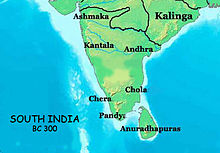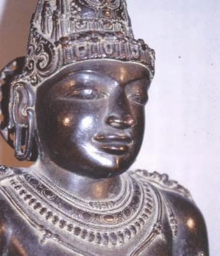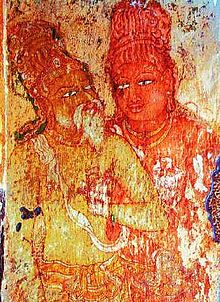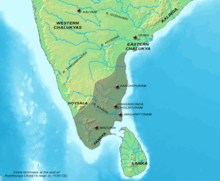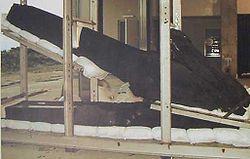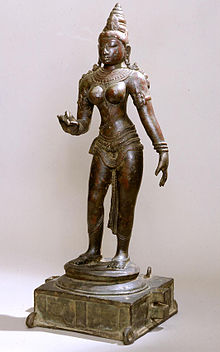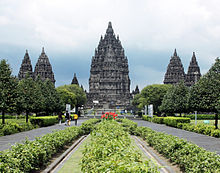
Chola dynasty
Background to the schools Wikipedia
Arranging a Wikipedia selection for schools in the developing world without internet was an initiative by SOS Children. See http://www.soschildren.org/sponsor-a-child to find out about child sponsorship.
| Chola Empire | |||||
|
|||||
|
Flag |
|||||
| Capital | Early Cholas: Poompuhar, Urayur, Tiruvarur, Medieval Cholas: Pazhaiyaarai, Thanjavur Gangaikonda Cholapuram |
||||
| Languages | Tamil | ||||
| Religion | Hinduism | ||||
| Government | Monarchy | ||||
| King | |||||
| - | 848–871 | Vijayalaya Chola | |||
| - | 1246–1279 | Rajendra Chola III | |||
| Historical era | Middle Ages | ||||
| - | Established | 300s BC | |||
| - | Rise of the medieval Cholas | 848 | |||
| - | Disestablished | 1279 | |||
| Today part of | |||||
|
||||||||||||||||||||||||||||||||||||||||||||||
|
||||||||||||||||||||||||||||||||||||||||||||||
|
||||||||||||||||||||||||||||||||||||||||||||||
Chola dynasty (Tamil:சோழர்) was a Tamil dynasty which was one of the longest-ruling dynasties in southern India. The earliest datable references to this Tamil dynasty are in inscriptions from the 3rd century BC left by Asoka, of Maurya Empire; as one of the Three Crowned Kings, the dynasty continued to govern over varying territory until the 13th century AD.
The heartland of the Cholas was the fertile valley of the Kaveri River, but they ruled a significantly larger area at the height of their power from the later half of the 9th century till the beginning of the 13th century. The whole country south of the Tungabhadra was united and held as one state for a period of two centuries and more. Under Rajaraja Chola I and his son Rajendra Chola I, the dynasty became a military, economic and cultural power in South Asia and South-east Asia. The power of the new empire was proclaimed to the eastern world by the expedition to the Ganges which Rajendra Chola I undertook and by the occupation of the maritime empire of Srivijaya, as well as by the repeated embassies to China.
During the period 1010–1200, the Chola territories stretched from the islands of the Maldives in the south to as far north as the banks of the Godavari River in Andhra Pradesh. Rajaraja Chola conquered peninsular South India, annexed parts of what is now Sri Lanka and occupied the islands of the Maldives. Rajendra Chola sent a victorious expedition to North India that touched the river Ganges and defeated the Pala ruler of Pataliputra, Mahipala. He also successfully invaded kingdoms of the Malay Archipelago. The Chola dynasty went into decline at the beginning of the 13th century with the rise of the Pandyas, who ultimately caused their downfall.
The Cholas left a lasting legacy. Their patronage of Tamil literature and their zeal in the building of temples has resulted in some great works of Tamil literature and architecture. The Chola kings were avid builders and envisioned the temples in their kingdoms not only as places of worship but also as centres of economic activity. They pioneered a centralised form of government and established a disciplined bureaucracy.
Origins
There is very little information available regarding the origin of the Chola Dynasty. The antiquity of this dynasty is evident from the mentions in ancient Tamil literature and in inscriptions. Later medieval Cholas also claimed a long and ancient lineage to their dynasty. Mentions in the early Sangam literature (c. 150 CE) indicate that the earliest kings of the dynasty antedated 100 CE. Parimelalagar, the annotator of the Tamil classic Tirukkural, mentions that this could be the name of an ancient king.
The most commonly held view is that this is, like Cheras and Pandyas, the name of the ruling family or clan of immemorial antiquity. The annotator Parimelazhagar writes "The charity of people with ancient lineage (such as the Cholas, the Pandyas and the Cheras) are forever generous in spite of their reduced means". Other names in common use for the Cholas are Killi (கிள்ளி), Valavan (வளவன்) and Sembiyan (செம்பியன்). Killi perhaps comes from the Tamil kil (கிள்) meaning dig or cleave and conveys the idea of a digger or a worker of the land. This word often forms an integral part of early Chola names like Nedunkilli, Nalankilli and so on, but almost drops out of use in later times. Valavan is most probably connected with 'valam' (வளம்) – fertility and means owner or ruler of a fertile country. Sembiyan is generally taken to mean a descendant of Shibi – a legendary hero whose self-sacrifice in saving a dove from the pursuit of a falcon figures among the early Chola legends and forms the subject matter of the Sibi Jataka among the Jataka stories of Buddhism. In Tamil lexicon Chola means Soazhi or Saei denoting a newly formed kingdom, in the lines of Pandya or the old country. Sora or Chozha in Tamil becomes Chola in Sanskrit and Chola or Choda in Telugu.
On the history of the early Cholas there is very little authentic written evidence available. Historians during the past 150 years have gleaned a lot of knowledge on the subject from a variety of sources such as ancient Tamil Sangam literature, oral traditions, religious texts, temple and copperplate inscriptions. The main source for the available information of the early Cholas is the early Tamil literature of the Sangam Period. There are also brief notices on the Chola country and its towns, ports and commerce furnished by the Periplus of the Erythraean Sea (Periplus Maris Erythraei). Periplus is a work by an anonymous Alexandrian merchant, written in the time of Domitian (81–96) and contains very little information of the Chola country. Writing half a century later, the geographer Ptolemy gives more detail about the Chola country, its port and its inland cities. Mahavamsa, a Buddhist text written down during the 5th century CE, recounts a number of conflicts between the inhabitants of Ceylon and Cholas in the 1st century BCE. Cholas are mentioned in the Pillars of Ashoka (inscribed 273 BCE–232 BCE) inscriptions, where they are mentioned among the kingdoms which, though not subject to Ashoka, were on friendly terms with him.
History
The history of the Cholas falls into four periods: the early Cholas of the Sangam literature, the interregnum between the fall of the Sangam Cholas and the rise of the medieval Cholas under Vijayalaya (c. 848), the dynasty of Vijayalaya, and finally the Later Chola dynasty of Kulothunga Chola I from the third quarter of the 11th century.
Early Cholas
The earliest Chola kings for whom there is tangible evidence are mentioned in the Sangam literature. Scholars generally agree that this literature belongs to the second or first few centuries of the common era. The internal chronology of this literature is still far from settled, and at present a connected account of the history of the period cannot be derived. The Sangam literature records the names of the kings and the princes, and of the poets who extolled them. Despite a rich literature that depicts the life and work of these people, these cannot be worked into connected history.
The Sangam literature also records legends about mythical Chola kings. These myths speak of the Chola king Kantaman, a supposed contemporary of the sage Agastya, whose devotion brought the river Kaveri into existence. Besides, two names stand out prominently from among those Chola kings known to have existed who feature in Sangam literature: Karikala Chola and Kocengannan. There are no sure means of settling the order of succession, of fixing their relations with one another and with many other princelings of about the same period. Urayur (now in/part-of Thiruchirapalli) was their oldest capital. Kaveripattinam also served as an early Chola capital. The Mahavamsa mentions that an ethnic Tamil adventurer, a Chola prince known as Elara, invaded the island around 235 BCE and that King Gajabahu visited Chera Cenguttuvan around 108 CE.
Interregnum
There is not much information about the transition period of around three centuries from the end of the Sangam age (c. 300) to that in which the Pandyas and Pallavas dominated the Tamil country. An obscure dynasty, the Kalabhras, invaded the Tamil country, displaced the existing kingdoms and ruled for around three centuries. They were displaced by the Pallavas and the Pandyas in the 6th century. Little is known of the fate of the Cholas during the succeeding three centuries until the accession of Vijayalaya in the second quarter of the 9th century.
Epigraphy and literature provide a few faint glimpses of the transformations that came over this ancient line of kings during this long interval. What is certain is that when the power of the Cholas fell to its lowest ebb and that of the Pandyas and Pallavas rose to the north and south of them, this dynasty was compelled to seek refuge and patronage under their more successful rivals. The Cholas continued to rule over a diminished territory in the neighbourhood of Uraiyur, but only in a minor capacity. In spite of their reduced powers, the Pandayas and Pallavas accepted Chola princesses in marriage, possibly out of regard for their reputation. Numerous inscriptions of Pallavas of this period mention their having fought rulers of 'the Chola country'. Despite this loss in influence and power, it is unlikely that the Cholas lost total grip of the territory around Uraiyur, their old capital, as Vijayalaya, when he rose to prominence hailed from this geographical area.
Around the 7th century, a Chola kingdom flourished in present-day Andhra Pradesh. These Telugu Cholas (or Chodas) traced their descent to the early Sangam Cholas. However, it is not known if they had any relation to the early Cholas. It is possible that a branch of the Tamil Cholas migrated north during the time of the Pallavas to establish a kingdom of their own, away from the dominating influences of the Pandyas and Pallavas. The Chinese pilgrim Xuanzang, who spent several months in Kanchipuram during 639–640 writes about the 'kingdom of Culi-ya', in an apparent reference to the Telugu Chodas.
Medieval Cholas
While there is little reliable information on the Cholas during the period between the early Cholas and Vijayalaya dynasties, there is an abundance of materials from diverse sources on the Vijayalaya and the Later Chola dynasties. A large number of stone inscriptions by the Cholas themselves and by their rival kings, Pandyas and Chalukyas, and copper-plate grants, have been instrumental in constructing the history of Cholas of that period. Vijayalaya, possibly a feudaory of Pallavas, took an opportunity arising out of a conflict between Pandyas and Pallavas in c. 850 CE, captured Thanjavur from Muttarayar and established the imperial line of the medieval Cholas.
The Chola dynasty was at the peak of its influence and power during the medieval period. Through their leadership and vision, kings such as the second Chola King Aditya I who caused the demise of the Pallavas, defeated the Pandyas of Madurai and occupied very large parts of the Kannada country and had marital ties with the Gangas, way back in 885 AD, his son Parantaka I, who conquered Sri Lanka known as Ilangai way back in 925 AD, Sundara Chola, also known as Parantaka Chola II who regained territories from the Rashtrakutas and expanded the Chola dominions up to Bhatkal in Kannada country, Rajaraja Chola I and Rajendra Chola I extended the Chola kingdom beyond the traditional limits of a Tamil kingdom. At its peak, the Chola Empire stretched from the island of Sri Lanka in the south to the Godavari- Krishna basin in the north, up to the Konkan coast in Bhatkal, the entire Malabar Coast in addition to Lakshadweep, Maldives and vast areas of Chera country. The kingdoms of Deccan and the eastern coast were subordinates, feudatories of the Cholas or other kingdoms like the Chalukyas between 1000–1075 AD paid tribute to the Cholas. Rajendra Chola I completed the conquest of the island of Sri Lanka and captured the Sinhala king Mahinda V prisoner, in addition to his conquests of Rattapadi (territories of the Rashtrakutas, Chalukya country, Talakkad, Kolar (where the Kolaramma temple still has his portrait statue) in Kannada country. Rajendra's territories included the area falling on the Ganges-Hooghly-Damodar basin, as well as Sri Lanka and Maldives. The kingdoms along the east coast of India up to the river Ganges acknowledged Chola suzerainty. Chola navies invaded and spread their influence to Srivijaya in the Malayan archipelago. Three diplomatic missions were sent to China in 1016, 1033 and 1077 CE.
The Western Chalukyas under Satyasraya and Somesvara I tried to wriggle out of Chola domination from time to time, primarily due to the Chola influence in the Vengi kingdom. The Western Chalukyas mounted several unsuccessful attempts to engage the Chola emperors in war and except for a brief occupation of Vengi territories between 1118–1126, all their other attempts ended in failure with successive Chola emperors routing the armies of the Chalukyas at various places in many wars. Cholas always successfully controlled the Chalukyas in the western Deccan by defeating them in war and levying tribute on them. Even under the emperors of the Cholas like Kulothunga I and Vikrama Chola the wars against the Chalukyas were mainly fought in Chalukya territories in Karnataka or in the Telugu country like Vengi, Kakinada or Anantapur or Gutti. Then the small Kannada kingdoms of the Kadambas, Hoysalas, Vaidumbas or Kalachuris, steadily increased their and finally replaced the Chalukyas. With the occupation of Dharwar in North Central Karnataka by the Hoysalas under Vishnuvardhana where he based himself with his son Narasimha I in-charge at the Hoysala capital Dwarasamudra around AD 1149, and with the Kalachuris occupying the Chalukyan capital for over 35 years from around 1150–1151 AD, the Chalukya kingdom was already starting to dissolve.
The Cholas under Kulothunga Chola III even collaborated to the herald the dissolution of the Chalukyas by aiding Hoysalas under Veera Ballala II, the son-in-law of the Chola monarch, and defeated the Western Chalukyas in a series of wars with Somesvara IV between 1185–1190 AD. The last Chalukya king's territories did not even include the erstwhile Chalukyan capitals Badami, Manyakheta or Kalyani. That was the final dissolution of Chalukyan power though the Chalukyas existed only in name since 1135–1140. But the Cholas remained stable till 1215 AD, were absorbed by the Pandiyan empire and ceased to exist by 1279 AD.
On the other hand, throughout the period from 1150–1280 AD, the staunchest opponents of the Cholas were Pandya princes who tried to win independence for their traditional territories. This period saw constant warfare between the Cholas and the Pandyas. The Cholas also fought regular wars with the Eastern Gangas of Kalinga, protected Vengi though it remained largely independent under Chola control, and had domination of the entire eastern coast with their feudatories the Telugu Chodas, Velananti Cholas, Renandu Cholas etc. who also always aided the Cholas in their successful campaigns against the Chalukyas and levying tribute on the Kannada kingdoms and fought constantly with the Sinhalas, who attempted to overthrow the Chola occupation of Lanka, but till the time of the Later Chola king Kulottunga I the Cholas had firm control over Lanka. In fact, a Later Chola king Rajadhiraja Chola II was strong enough to prevail over a confederation of five Pandya princes who were aided by their traditional friend, the king of Lanka, this once again gave control of Lanka to the Cholas despite the fact that they were not strong under the resolute Rajadhiraja Chola II. However, Rajadhiraja Chola II's successor, the last great Chola monarch Kulottunga Chola III reinforced the hold of the Cholas by quelling rebellion and disturbances in Lanka and Madurai, defeated Hoysala generals under Veera Ballala II in Karuvur, in addition to holding on to his traditional territories in Tamil country, Eastern Gangavadi, Draksharama, Vengi and Kalinga. After this, he entered into a marital alliance with Veera Ballala II (with Ballala's marriage to a Chola princess) and his relationship with Hoysalas seems to have become friendlier.
Later Cholas (1070–1279 AD)
Marital and political alliances between the Eastern Chalukyas began during the reign of Rajaraja following his invasion of Vengi. Rajaraja Chola's daughter married Chalukya prince Vimaladitya. Rajendra Chola's daughter was also married to an eastern Chalukya prince Rajaraja Narendra.
Virarajendra Chola's son Athirajendra Chola was assassinated in a civil disturbance in 1070, and Kulothunga Chola I, the son of Rajaraja Narendra, ascended the Chola throne starting the Later Chola dynasty.
The Later Chola dynasty saw capable rulers in Kulothunga Chola I, his son Vikrama Chola, other successors like Rajaraja Chola II, Rajadhiraja Chola II and the great Kulothunga Chola III, who conquered Kalinga, Ilam and Kataha. However, the rule of the later Cholas between 1218 AD, starting with Rajaraja Chola II to the last emperor Rajendra Chola III was not as strong as those of the emperors between 850–1215 AD. Around 1118, they lost control of Vengi to the Western Chalukya and Gangavadi (southern Mysore districts) to the Hoysalas. However, these were only temporary setbacks, because immediately following the accession of king Vikrama Chola, the son and successor of Kulothunga Chola I, the Cholas lost no time in recovering the province of Vengi by defeating Chalukya Somesvara III and also recovering Gangavadi from the Hoysalas. The Chola Empire, though not as strong as between 850–1150, was still largely territorially intact under Raja Raja Chola II (1146–1175 AD) a fact attested by the construction and completion of the third grand Chola architectural marvel, the chariot-shaped Airavatesvara Temple at Dharasuram on the outskirts of modern Kumbakonam. This temple is part of the World Heritage Sites trinity of the Great Living Chola Temples, along with the Brihadeeswarar Temples of Thanjavur and Gangaikonda Cholapuram, built by his predecessors Raja Raja Chola I and Rajendra Chola I, respectively. Chola administration and territorial integrity till the rule of Kulothunga Chola III was stable and very prosperous up to 1215 AD, but during his rule itself, the decline of the Chola power started following his defeat by Maravarman Sundara Pandiyan II in 1215–16 AD. Subsequently, the Cholas also lost control of the island of Lanka and were driven out by the revival of Sinhala power.
In continuation of the decline, also marked by the resurgence of the Pandyas as the most powerful rulers in South India, a lack of a controlling central administration in its erstwhile-Pandyan territories prompted a number of claimants to the Pandya throne to cause a civil war in which the Sinhalas and the Cholas were involved by proxy. Details of the Pandyan civil war and the role played by the Cholas and Sinhalas, are present in the Mahavamsa as well as the Pallavarayanpettai Inscriptions.
The Cholas, under Rajaraja Chola III and later, his successor Rajendra Chola III, were quite weak and therefore, experienced continuous trouble. One feudatory, the Kadava chieftain Kopperunchinga I, even held Rajaraja Chola III as hostage for sometime. At the close of the 12th century, the growing influence of the Hoysalas replaced the declining Chalukyas as the main player in the Kannada country, but they too faced constant trouble from the Seunas and the Kalachuris who were occupying Chalukya capital for those empires were their new rivals. So naturally, the Hoysalas found it convenient to have friendly relations with the Cholas from the time of Kulothunga Chola III, who had defeated Hoysala Veera Ballala II, who had subsequent marital relations with the Chola monarch. This continued during the time of Rajaraja Chola III the son and successor of Kulothunga Chola III
The Pandyas in the south had risen to the rank of a great power who ultimately banished the Hoysalas from Malanadu or Kannada country, who were allies of the Cholas from Tamil country and the demise of the Cholas themselves ultimately was caused by the Pandyas in AD 1279. The Pandyas first steadily gained control of the Tamil country as well as territories in Sri Lanka, Chera country, Telugu country under Maravarman Sundara Pandiyan II and his able successor Jatavarman Sundara Pandyan before inflicting several defeats on the joint forces of the Cholas under Rajaraja Chola III, his successor Rajendra Chola III and the Hoysalas under Someshwara, his son Ramanatha Rajendra III tried to survive by aligning with the Kadava Pallavas and the Hoysalas in turn in order to counter the constantly rising power of the Pandyans who were the major players in the Tamil country from AD 1215 and had intelligently consolidated their position in Madurai-Rameswaram-Ilam-Cheranadu and Kanniyakumari belt, and had been steadily increasing their territories in the Kaveri belt between Dindigul-Tiruchy-Karur-Satyamangalam as well as in the Kaveri Delta i.e. Thanjavur-Mayuram-Chidambaram-Vriddhachalam-Kanchi, finally marching all the way up to Arcot—Tirumalai-Nellore-Visayawadai-Vengi-Kalingam belt by 1250 AD.
The Pandyas steadily routed both the Hoysalas and the Cholas. They also dispossessed the Hoysalas, who had been overestimating their power by interfering in the politics of Tamil country by routing them under Jatavarman Sundara Pandiyan at Kannanur Kuppam and chased them back to the Mysore plateau and stopped the war only thereafter. At the close of Rajendra's reign, the Pandyan empire was at the height of prosperity and had taken the place of the Chola empire in the eyes of the foreign observers. The last recorded date of Rajendra III is 1279. There is no evidence that Rajendra was followed immediately by another Chola prince. The Hoysalas were routed from Kannanur Kuppam around 1279 by Kulasekhara Pandiyan and in the same war the last Chola emperor Rajendra III was routed and the Chola empire ceased to exist thereafter. Thus the Chola empire was completely overshadowed by the Pandyan empire and sank into obscurity and ceased to exist by the end of the 13th century.
Government and society
Chola country
According to Tamil tradition, the old Chola country comprised the region that includes the modern-day Tiruchirapalli District, Tiruvarur District, Nagapattinam District, Ariyalur District, Perambalur district, Pudukkottai district, Pichavaram Taluk and the Thanjavur District in Tamil Nadu and Karaikal District in Karaikal. The river Kaveri and its tributaries dominate this landscape of generally flat country that gradually slopes towards the sea, unbroken by major hills or valleys. The river Kaveri, also known as Ponni (golden) river, had a special place in the culture of Cholas. The annual floods in the Kaveri marked an occasion for celebration, Adiperukku, in which the whole nation took part.
Kaveripoompattinam on the coast near the Kaveri delta was a major port town. Ptolemy knew of this and the other port town of Nagappattinam as the most important centres of Cholas. These two towns became hubs of trade and commerce and attracted many religious faiths, including Buddhism. Roman ships found their way into these ports. Roman coins dating from the early centuries of the common era have been found near the Kaveri delta.
The other major towns were Thanjavur, Uraiyur and Kudanthai, now known as Kumbakonam. After Rajendra Chola moved his capital to Gangaikonda Cholapuram, Thanjavur lost its importance. The later Chola kings moved around their capitals frequently and made cities such as Chidambaram, Madurai and Kanchipuram their regional capitals.
Nature of government
In the age of the Cholas, the whole of South India was, for the first time ever, brought under a single government. when a serious attempt was made to face and solve the problems of public administration. The Cholas' system of government was monarchical, as in the Sangam age. However, there was little in common between the local chiefdoms of the earlier period and the imperial-like states of Rajaraja Chola and his successors.
Between 980 and c. 1150, the Chola Empire comprised the entire south Indian peninsula, extending from the east coast to the west coast and bounded to the north by an irregular line along the Tungabhadra river and the Vengi frontier. Although Vengi had a separate political existence, it was closely connected to the Chola Empire and the Chola dominion virtually extended up to the banks of the Godavari river.
Thanjavur and later Gangaikonda Cholapuram were the imperial capitals. However both Kanchipuram and Madurai were considered to be regional capitals in which occasional courts were held. The king was the supreme leader and a benevolent authoritarian. His administrative role consisted of issuing oral commands to responsible officers when representations were made to him. A powerful bureaucracy assisted the king in the tasks of administration and in executing his orders. Due to the lack of a legislature or a legislative system in the modern sense, the fairness of king's orders dependent on his morality and belief in Dharma. The Chola kings built temples and endowed them with great wealth. The temples acted not only as places of worship but also as centres of economic activity, benefiting the community as a whole.
Local government
Every village was a self-governing unit. A number of villages constituted a larger entity known as a Kurram, Nadu or Kottram, depending on the area. A number of Kurrams constituted a valanadu. These structures underwent constant change and refinement throughout the Chola period.
Justice was mostly a local matter in the Chola Empire; minor disputes were settled at the village level. Punishment for minor crimes were in the form of fines or a direction for the offender to donate to some charitable endowment. Even crimes such as manslaughter or murder were punished with fines. Crimes of the state, such as treason, were heard and decided by the king himself; the typical punishment in these cases was either execution or the confiscation of property.
Foreign trade
The Cholas excelled in foreign trade and maritime activity, extending their influence overseas to China and Southeast Asia. Towards the end of the 9th century, southern India had developed extensive maritime and commercial activity. The Cholas, being in possession of parts of both the west and the east coasts of peninsular India, were at the forefront of these ventures. The Tang dynasty of China, the Srivijaya empire in the Malayan archipelago under the Sailendras, and the Abbasid Kalifat at Baghdad were the main trading partners.
Chinese Song Dynasty reports record that an embassy from Chulian (Chola) reached the Chinese court in the year 1077, and that the king of the Chulien at the time, Kulothunga I, was called Ti-hua-kia-lo. This embassy was a trading venture and was highly profitable to the visitors, who returned with copper coins in exchange for articles of tributes, including glass articles, and spices. Chinese records rarely described Tamil merchants. On the other hand, a fragmentary Tamil inscription found in Sumatra cites the name of a merchant guild Nanadesa Tisaiyayirattu Ainnutruvar (literally, "the five hundred from the four countries and the thousand directions"), a famous merchant guild in the Chola country. The inscription is dated 1088, indicating that there was an active overseas trade during the Chola period. Six other inscriptions have been found across South-East Asia and bear testimony to merchant activities as well as to the naming of trade-related places and public work in that region after members of the Tamil royal family. Probably, the motive behind Rajendra's expedition to Srivijaya was the protection of the merchants' interests.
Chola society
There is little information on the size and the density of the population during the Chola reign. The stability in the core Chola region enabled the people to lead a productive and contented life. There is only one recorded instance of civil disturbance during the entire period of Chola reign. However, there were reports of widespread famine caused by natural calamities.
The quality of the inscriptions of the regime indicates a high level of literacy and education in the society. The text in these inscriptions was written by court poets and engraved by talented artisans. Education in the contemporary sense was not considered important; there is circumstantial evidence to suggest that some village councils organised schools to teach the basics of reading and writing to children, although there is no evidence of systematic educational system for the masses. Vocational education was through hereditary training in which the father passed on his skills to his sons. Tamil was the medium of education for the masses; Religious monasteries (matha or gatika) were centres of learning and received government support.
Cultural contributions
Under the Cholas, the Tamil country reached new heights of excellence in art, religion and literature. In all of these spheres, the Chola period marked the culmination of movements that had begun in an earlier age under the Pallavas. Monumental architecture in the form of majestic temples and sculpture in stone and bronze reached a finesse never before achieved in India.
The Chola conquest of Kadaram ( Kedah) and Srivijaya, and their continued commercial contacts with the Chinese Empire, enabled them to influence the local cultures. Many of the surviving examples of the Hindu cultural influence found today throughout the Southeast Asia owe much to the legacy of the Cholas.
Art
The Cholas continued the temple-building traditions of the Pallava dynasty and contributed significantly to the Dravidian temple design. They built a number of Siva temples along the banks of the river Kaveri. The template for these and future temples was formulated by Aditya I and Parantaka.
Temple building received great impetus from the conquests and the genius of Rajaraja Chola and his son Rajendra Chola I. The maturity and grandeur to which the Chola architecture had evolved found expression in the two temples of Thanjavur and Gangaikondacholapuram. The magnificent Siva temple of Thanjavur, completed around 1009, is a fitting memorial to the material achievements of the time of Rajaraja. The largest and tallest of all Indian temples of its time, it is at the apex of South Indian architecture. The temple of Gangaikondacholisvaram at Gangaikondacholapuram, the creation of Rajendra Chola, was intended to excel its predecessor. Completed around 1030, only two decades after the temple at Thanjavur and in the same style, the greater elaboration in its appearance attests the more affluent state of the Chola Empire under Rajendra. The Brihadisvara Temple, the temple of Gangaikondacholisvaram and the Airavatesvara Temple at Darasuram were declared as World Heritage Sites by the UNESCO and are referred to as the Great living Chola temples.
The Chola period is also remarkable for its sculptures and bronzes. Among the existing specimens in museums around the world and in the temples of South India may be seen many fine figures of Siva in various forms, such as Vishnu and his consort Lakshmi, and the Saivaite saints. Though conforming generally to the iconographic conventions established by long tradition, the sculptors worked with great freedom in the 11th and the 12th centuries to achieve a classic grace and grandeur. The best example of this can be seen in the form of Nataraja the Divine Dancer.
Literature
The age of the Imperial Cholas (850–1200) was the golden age of Tamil culture, marked by the importance of literature. Chola inscriptions cite many works, the majority of which have been lost.
The revival of Hinduism from its nadir during the Kalabhras spurred the construction of numerous temples and these in turn generated Saiva and Vaishnava devotional literature. Jain and Buddhist authors flourished as well, although in fewer numbers than in previous centuries. Jivaka-chintamani by Tirutakkatevar and Sulamani by Tolamoli are among notable by non-Hindu authors. The art of Tirutakkatevar is marked by all the qualities of great poetry. It is considered as the model for Kamban for his masterpiece Ramavataram.
Kamban flourished during the reign of Kulothunga Chola III. His Ramavatharam (also referred to as Kambaramayanam) is an epic in Tamil literature, and although the author states that he followed Valmiki's Ramayana, it is generally accepted that his work is not a simple translation or adaptation of the Sanskrit epic. Kamban imports into his narration the colour and landscape of his own time; his description of Kosala is an idealised account of the features of the Chola country.
Jayamkondar's masterpiece Kalingattuparani is an example of narrative poetry that draws a clear boundary between history and fictitious conventions. This describes the events during Kulothunga Chola I's war in Kalinga and depicts not only the pomp and circumstance of war, but the gruesome details of the field. The famous Tamil poet Ottakuttan was a contemporary of Kulothunga Chola I and served at the courts of three of Kulothunga's successors. Ottakuttan wrote Kulothunga Cholan Ula, a poem extolling the virtues of the Chola king.
The impulse to produce devotional religious literature continued into the Chola period and the arrangement of the Saiva canon into 11 books was the work of Nambi Andar Nambi, who lived close to the end of 10th century. However, relatively few Vaishnavite works were composed during the later Chola period, possibly because of the apparent animosity towards the Vaishnavites by the Later Chola monarchs.
Religion

In general, Cholas were the adherents of Hinduism. Throughout their history, they were not swayed by the rise of Buddhism and Jainism as were the kings of the Pallava and Pandya dynasties. Even the early Cholas followed a version of the classical Hindu faith. There is evidence in Purananuru for Karikala Chola's faith in Saivism in the Tamil country. Kocengannan, another early Chola, was celebrated in both Sangam literature and in the Saiva canon as a saint.
While the Cholas did build their largest and most important temple dedicated to Lord Shiva, it can be by no means concluded that either they were staunch Saivites or followers of Saivism only or that they were not favourably disposed to other faiths. This is borne out by the fact that the second Chola king Aditya I himself built quite a few temples for Siva and for Lord Vishnu. In AD 890, his inscriptions speak of his contributions to the construction of the Ranganatha Temple at Srirangapatnam (now in Mandya district of Karnataka) in the country of Western Gangas who were both his feudatories and had marital relations with him. During the time of Aditya I (871–903 AD) the Gangas of Kannada country had recognized his superiority which he acknowledged by marrying into that family and making grant contributions to the construction of the Sri Ranganatha temple at modern Srirangapatnam. Aditya I regularly gave many endowments to the Sri Ranganatha Temple at Srirangam around AD 896 and issued an inscriptional dictat pronouncing that the great temples of Siva and the Ranganatha temple at Srirangam to be the 'Kuladhanam' of the Chola emperors.
It was Aditya I's dictat which was faithfully carried out by his illustrious son Parantaka I and his successors wherein it was declared in edicts that the Siva Temple of Chidambaram (at that time the grand Siva temples of Tanjore and Gangaikonda Cholapuram were not in existence) and the Sri Ranganatha Swami temple of Srirangam were the 'Kuladhanams', i.e., tutelary (deities) treasures of the Chola emperors. This dictat was repeated around 300 years back when the last great Chola King, Kulothunga III, the builder of the great Sarabeswarar Temple at Tribhuvanam on the outskirts of Kumbakonam, hails Lord Ranganatha at Srirangam in an inscription in the Srirangam Koil, as his 'tutelary deity'. As per findings of Dr. Hultzsch, the great epigraphist, in this inscription acknowledgment is made to the earlier great Chola king Parantaka about declaring the Chidambaram (Siva) Koil and the Srirangam (Vishnu) Koil as 'Kuladhanams' of the Cholas – a pointer to the fact that the Cholas were secular and patronized equally all religions and sub-sects within the same religion. Another proof of this is the existence of as many as 40 Vaishnava Divyadesams out of 108 such temples in the Chola country, which are functioning and flourishing even today.
Chola king Sundara (Parantaka II) was a staunch devotee of the reclining Vishnu (Vadivu Azhagiya Nambi) at Anbil in the banks of Cauvery on the outskirts of Tiruchy, to whom he gave numerous gifts and embellishments, and prayed before him by keeping his sword before the deity, beforeo his proceeding for war for regaining the territories in and around Kanchi and Arcot from the waning Rashtrakutas and while leading expeditions against both Madurai and Ilam (Sri Lanka). Parantaka I and Sundara Chola endowed and built temples for Siva and Vishnu. Rajaraja Chola I patronised Buddhists and provided for the construction of the Chudamani Vihara (a Buddhist monastery) in Nagapattinam at the request of the Srivijaya Sailendra king. While it is true that the biggest and grandest temples of the Cholas were dedicated to Lord Siva, all Chola kings especially from Aditya to Rajendra IV built great temples for Lord Vishnu and gave numerous grants and gifts to them.
During the period of Later Cholas, there were supposedly instances of intolerance towards Vaishnavites, especially towards Ramanuja, the acharya of the Vaishnavites. Kulothunga Chola II, a staunch Saivite, is said to have removed a statue of Vishnu from the Siva temple at Chidambaram, though there are no epigraphical evidences to support this theory. There is an inscription from 1160 that the custodians of Siva temples who had social intercourses with Vaishnavites would forfeit their property. However, this is more of a direction to the Saivite community by its religious heads than any kind of dictat by a Chola emperor. While Chola kings built their largest temples for Siva and even while emperors like Raja Raja Chola I held titles like 'Sivapadasekharan', in none of their inscriptions did the Chola emperors proclaim that their clan only and solely followed Saivism or that Saivism was the state religion during their rule.
In popular culture
The history of the Chola dynasty has inspired many Tamil authors to produce literary and artistic creations during the last several decades. The most important work of this genre is the popular Ponniyin Selvan (The son of Ponni), a historical novel in Tamil written by Kalki Krishnamurthy. Written in five volumes, this narrates the story of Rajaraja Chola. Ponniyin Selvan deals with the events leading up to the ascension of Uttama Chola to the Chola throne. Kalki had utilised the confusion in the succession to the Chola throne after the demise of Sundara Chola. This book was serialised in the Tamil periodical Kalki during the mid-1950s. The serialisation lasted for nearly five years and every week its publication was awaited with great interest.
Akilan's Vegaiyin Maindhan, a novel narrating the events surrounding the capture of Lankan King, Mahinda V and the building of Gangaikonda Cholapuram by Rajendra Chola I won the sahitya Akademi award for the year 1963.
Kalki's earlier historical romance Parthiban Kanavu deals with the fortunes of an imaginary Chola prince Vikraman, who was supposed to have lived as a feudatory of the Pallava king Narasimhavarman I during the 7th century. The period of the story lies within the interregnum during which the Chola in eclipse before Vijayalaya Chola revived their fortunes. Parthiban Kanavu was also serialised in the Kalki weekly during the early 1950s.
Sandilyan, another popular Tamil novelist, wrote Kadal Pura in the 1960s. It was serialised in the Tamil weekly Kumudam. Kadal Pura is set during the period when Kulothunga Chola I was in exile from the Vengi kingdom, after he was denied the throne. Kadal Pura speculates the whereabouts of Kulothunga during this period. Sandilyan's earlier work Yavana Rani written in the early 1960s is based on the life of Karikala Chola. More recently, Balakumaran wrote the novel Udaiyar based on the circumstances surrounding Rajaraja Chola's construction of the Brihadisvara Temple in Thanjavur.
There were stage productions based on the life of Rajaraja Chola during the 1950s and in 1973 Shivaji Ganesan acted in a screen adaptation of a play titled Rajaraja Cholan. The Cholas are featured in the History of the World board game, produced by Avalon Hill.

